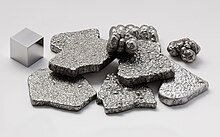**Properties of Metals:**
– Metals are shiny, lustrous, and can appear opaque.
– They readily lose outer shell electrons due to metallic bonding.
– Different metals have varying densities.
– Metals are malleable, ductile, and follow Hookes Law for deformation.
– They have common crystal structures and exhibit plasticity.
– Metals conduct electricity and have high thermal conductivity.
– They vary in electrical resistivity and have distinct energy states for electrons.
**Chemical Properties and Applications of Metals:**
– Metals can form alloys and compounds.
– They make up a significant portion of the Earth’s crust.
– Metals have historical and modern uses in various applications.
– Some nonmetals can exhibit metallic properties under high pressure.
– Metalloids like arsenic and antimony blur metal classifications.
– Metals are used in high-rise buildings, vehicles, home appliances, and more.
**Metals in the Periodic Table and Alloys:**
– Metals are distributed in the periodic table.
– Alloys are mixtures that modify pure metals.
– Steel, stainless steel, and aerospace alloys are significant.
– Alloys have expanded the applications of metals.
– The periodic table includes highly radioactive elements, metalloids, and pressure effects.
**Categories of Metals:**
– Metals are categorized based on properties.
– Ferrous metals contain iron, while non-ferrous metals do not.
– Brittle metals like beryllium and chromium exhibit brittleness.
– Refractory metals such as niobium and tantalum are heat-resistant.
– White metals like zinc and cadmium have low melting points and are white-colored.
– Heavy metals are dense and may have toxic properties, while light metals include aluminum and magnesium.
**Metals and Their Specific Characteristics:**
– Ferrous metallurgy and non-ferrous metal are key areas of study.
– Brittle metals have low bulk elastic modulus to shear modulus ratios.
– Refractory metals have high melting points and hardness.
– White metals have low melting points and toxic variants.
– Heavy metals can be toxic, while light metals have niche uses or are essential in trace amounts.
A metal (from Ancient Greek μέταλλον (métallon) 'mine, quarry, metal') is a material that, when freshly prepared, polished, or fractured, shows a lustrous appearance, and conducts electricity and heat relatively well. Metals are typically ductile (can be drawn into wires) and malleable (they can be hammered into thin sheets). These properties are the result of the metallic bond between the atoms or molecules of the metal.


A metal may be a chemical element such as iron; an alloy such as stainless steel; or a molecular compound such as polymeric sulfur nitride.
In physics, a metal is generally regarded as any substance capable of conducting electricity at a temperature of absolute zero. Many elements and compounds that are not normally classified as metals become metallic under high pressures. For example, the nonmetal iodine gradually becomes a metal at a pressure of between 40 and 170 thousand times atmospheric pressure. Equally, some materials regarded as metals can become nonmetals. Sodium, for example, becomes a nonmetal at pressure of just under two million times atmospheric pressure, though at even higher pressures it is expected to become a metal again.
In chemistry, two elements that would otherwise qualify (in physics) as brittle metals—arsenic and antimony—are commonly instead recognised as metalloids due to their chemistry (predominantly non-metallic for arsenic, and balanced between metallicity and nonmetallicity for antimony). Around 95 of the 118 elements in the periodic table are metals (or are likely to be such). The number is inexact as the boundaries between metals, nonmetals, and metalloids fluctuate slightly due to a lack of universally accepted definitions of the categories involved.
In astrophysics the term "metal" is cast more widely to refer to all chemical elements in a star that are heavier than helium, and not just traditional metals. In this sense the first four "metals" collecting in stellar cores through nucleosynthesis are carbon, nitrogen, oxygen, and neon, all of which are strictly non-metals in chemistry. A star fuses lighter atoms, mostly hydrogen and helium, into heavier atoms over its lifetime. Used in that sense, the metallicity of an astronomical object is the proportion of its matter made up of the heavier chemical elements.
Metals, as chemical elements, comprise 25% of the Earth's crust and are present in many aspects of modern life. The strength and resilience of some metals has led to their frequent use in, for example, high-rise building and bridge construction, as well as most vehicles, many home appliances, tools, pipes, and railroad tracks. Precious metals were historically used as coinage, but in the modern era, coinage metals have extended to at least 23 of the chemical elements.
The history of refined metals is thought to begin with the use of copper about 11,000 years ago. Gold, silver, iron (as meteoric iron), lead, and brass were likewise in use before the first known appearance of bronze in the fifth millennium BCE. Subsequent developments include the production of early forms of steel; the discovery of sodium—the first light metal—in 1809; the rise of modern alloy steels; and, since the end of World War II, the development of more sophisticated alloys.
English
Etymology
From Middle English metal, a borrowing from Old French metal, from Latin metallum (“metal, mine, quarry, mineral”), itself a borrowing from Ancient Greek μέταλλον (métallon, “mine, quarry, metal”).





